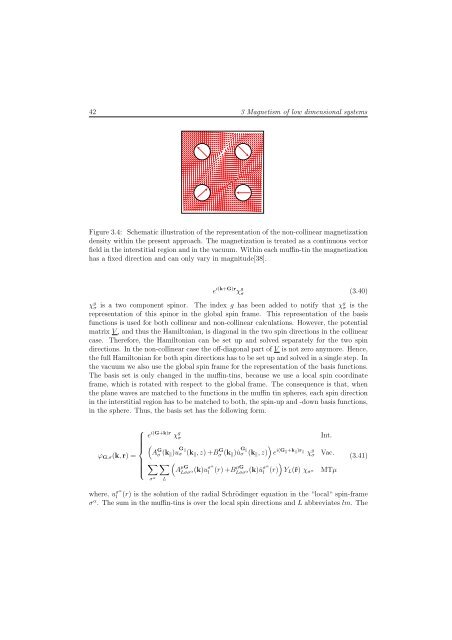Ab initio investigations of magnetic properties of ultrathin transition ...
Ab initio investigations of magnetic properties of ultrathin transition ...
Ab initio investigations of magnetic properties of ultrathin transition ...
Create successful ePaper yourself
Turn your PDF publications into a flip-book with our unique Google optimized e-Paper software.
42 3 Magnetism <strong>of</strong> low dimensional systems<br />
Figure 3.4: Schematic illustration <strong>of</strong> the representation <strong>of</strong> the non-collinear magnetization<br />
density within the present approach. The magnetization is treated as a continuous vector<br />
field in the interstitial region and in the vacuum. Within each muffin-tin the magnetization<br />
has a fixed direction and can only vary in magnitude[38].<br />
e i(k+G)r χ g σ<br />
(3.40)<br />
χg σ is a two component spinor. The index g has been added to notify that χg σ is the<br />
representation <strong>of</strong> this spinor in the global spin frame. This representation <strong>of</strong> the basis<br />
functions is used for both collinear and non-collinear calculations. However, the potential<br />
matrix V , and thus the Hamiltonian, is diagonal in the two spin directions in the collinear<br />
case. Therefore, the Hamiltonian can be set up and solved separately for the two spin<br />
directions. In the non-collinear case the <strong>of</strong>f-diagonal part <strong>of</strong> V is not zero anymore. Hence,<br />
the full Hamiltonian for both spin directions has to be set up and solved in a single step. In<br />
the vacuum we also use the global spin frame for the representation <strong>of</strong> the basis functions.<br />
The basis set is only changed in the muffin-tins, because we use a local spin coordinate<br />
frame, which is rotated with respect to the global frame. The consequence is that, when<br />
the plane waves are matched to the functions in the muffin tin spheres, each spin direction<br />
in the interstitial region has to be matched to both, the spin-up and -down basis functions,<br />
in the sphere. Thus, the basis set has the following form.<br />
⎧<br />
e<br />
⎪⎨<br />
ϕG,σ(k, r) =<br />
⎪⎩<br />
i(G+k)r χ g σ<br />
Int.<br />
�<br />
A G σ (k�)u G� σ (k�,z)+B G σ (k�)˙u G �<br />
�<br />
σ (k�,z) e i(G�+k�)r� g<br />
χσ Vac.<br />
� � �<br />
A μG<br />
Lσσα(k)uσα l (r)+B μG<br />
Lσσα(k)˙uσα �<br />
l (r) YL(ˆr) χσα MTμ<br />
σ α<br />
L<br />
(3.41)<br />
where, u σα<br />
l (r) is the solution <strong>of</strong> the radial Schrödinger equation in the “local“ spin-frame<br />
σ α . The sum in the muffin-tins is over the local spin directions and L abbreviates lm. The

















